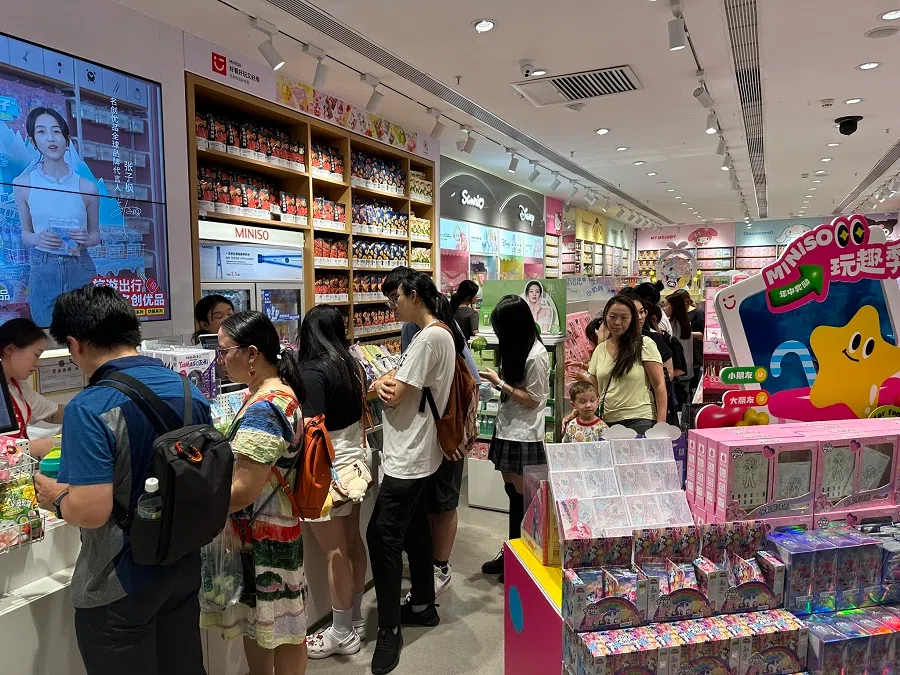Buying happiness: Chinese consumers splurge on blind boxes and trendy collectible toys
Amid a sluggish domestic consumption environment in China, Lianhe Zaobao correspondent Daryl Lim finds out why the collectible toy industry is bucking the trend.

(Photos: Daryl Lim/SPH Media, unless otherwise stated.)
By gently shaking a blind box, 33-year-old Mr Chen can roughly guess its content based on the overall weight and the sound the toy makes as it hits against the packaging.
Chen is a medical surgeon and also a trendy collectible toy enthusiast. Over the past two years, he has spent over 100,000 RMB (US$14,097) on blind boxes, accumulating thousands of collectible toys made under the intellectual property (IP) of Skullpanda, Dimoo, Crybaby and more.
Affordable source of happiness
A blind box series usually contains 12 regular figures and a rare edition, which you have a one in 144 chance of finding. Chen told Lianhe Zaobao that the joy of opening blind boxes does not come from the toy inside but in the moment you tear open the box — the thrill and anticipation that depends solely on luck, and the uncertainty of whether you will get the toy you want or the rare edition.
He said, “A typical blind box costs 69 RMB, but it can be worth ten times more if you get the rare edition. Unboxing a regular version is still fine because you can add another toy to your collection or resell any duplicates online.”
China’s sluggish economy has prompted people to reduce their expenses and cut back on non-essential spending, making the wave of consumption downgrading increasingly apparent. Yet the consumption of trendy toys and IP-related products is experiencing strong growth, reflecting a shift in China’s consumer habits — while they still look for value for money, consumers are increasingly leaning towards products with emotional value.
“Unlike big one-off expenditures such as travelling abroad, a blind box brings joy without breaking the bank. It is a source of happiness that we can still afford.” — Liang Meina, a blind box enthusiast

Several trendy collectible toy enthusiasts told me that they choose to collect toys from a specific series because they have a special emotional attachment to the characters. Some adults love collecting Crayon Shin-chan or B-Robo Kabutack toys because these characters evoke nostalgic memories of their childhoods. Some collect trendy toys related to specific movie IPs to commemorate and relive cherished moments with their loved ones.
Liang Meina, 29, who works in the financial sector, shared that many people face salary cuts amid the bad economy. She said, “Unlike big one-off expenditures such as travelling abroad, a blind box brings joy without breaking the bank. It is a source of happiness that we can still afford.”
Growing industry
According to the 2023 report on the development of the collectible toys industry issued by the Chinese Academy of Social Sciences’ National Academy of Economic Strategy, China’s collectible toys market is rapidly expanding and entering the ranks of a 100 billion RMB industry. Statistics show that the sector increased from 6.3 billion RMB in 2015 to 34.5 billion RMB in 2021, and is projected to reach 110.1 billion RMB by 2026.
This consumer group is also more willing to spend on collectible toys. Data show that the average monthly expenditure per consumer increased from 27 RMB in 2015 to 81 RMB in 2020, and is expected to reach 194 RMB by 2025 and 254 RMB by 2030.

Pop Mart, a typical representative of the trendy toys sector, saw its revenue from its domestic operations reach 5.235 billion RMB in 2023, a year-on-year increase of 25.8%. This growth accelerated in the first half of the year alone, increasing 31.5% year-on-year to reach 3.21 billion RMB.
During a visit to the COCO Park shopping complex in Futian, Shenzhen, I found at least five stores selling a variety of trendy toys just at the basement level. Besides the classic limited edition toys, there were also new designer brand toys. The complex was bustling from the waves of customers visiting these stores.
As IP becomes a key consumption driver, some businesses have shifted focus to an IP retail model in recent years, injecting new life and personality into traditional products and increasing their recognition and attractiveness.
Miniso is one such example. The business started off by imitating Japanese brands and selling “pseudo-Japanese style” daily necessities, but has gradually shifted focus to IP collaborations. Their product offerings include trendy IP toys, as well as daily necessities that are linked to these IPs.
Analysts pointed out that this strategic shift not only increased the value of these traditional products, it also spurred consumer purchasing interest and repeat purchases for daily necessities, bringing strong sales growth for the business.
Data from Miniso’s financial report showed that in the first half of 2024, the company opened 189 new stores in China, with revenue growing 25% year-on-year to reach 7.76 billion RMB — a historic high. IP products accounted for nearly 30% of the Chinese market, with sales growing almost 40% year-on-year.

Miniso’s trendy toy sub-brand Top Toy also grew significantly. In the first half of the year, it opened 47 new stores, with revenue and profit before tax both on the rise as well.
When it comes to trendy IP toys, overseas markets have a high level of demand for uniquely designed and creative products, and this has provided opportunities for continued growth for companies such as Pop Mart and Miniso.
Continue growth ahead
Against the backdrop of sluggish consumer spending in China, Miniso’s stellar sales figures are proof of the advantage of an IP-focused business model to uplift brand value and market competitiveness. The business estimates that its revenue for the Chinese market will continue to grow another 10% to 15% from last year’s rapid 42% growth.
Robin Liu, Miniso’s chief marketing officer, told Lianhe Zaobao that interest consumption is a new form of consumption that is on the rise, and consumers are willing to spend on products that have an additional emotional value attached to it in order to satisfy their desires for personalisation and cultural value, as well as products that serve the function of emotional attachment and social interaction.
Liu added, “The IP retail industry is a classic example of interest consumption. The scale of the global IP retail industry is around two trillion RMB, and it is currently in a highly dispersed state with huge potential for development.”
Amid the intense competition for the domestic Chinese market, the IP trendy toy industry has stepped up expansion overseas in the past few years, and gained even more recognition and profits from international markets. When it comes to trendy IP toys, overseas markets have a high level of demand for uniquely designed and creative products, and this has provided opportunities for continued growth for companies such as Pop Mart and Miniso.

Liu believes that interest consumption would eventually co-exist with rational consumption. He said, “The uncertainties in the global economy have made consumers more cautious when it comes to purchasing. This means that a highly effective and stable supply chain is an important foundation for the long-term development of businesses.”
He added, “When it comes to satisfying consumers’ demand for personalised and interest-guided products, cost-effectiveness should be considered, to provide consumers with high-quality products at a reasonable price.”
This article was first published in Lianhe Zaobao as “中国消费降级IP潮玩逆袭”.

![[Big read] Paying for pleasure: Chinese women indulge in handsome male hosts](https://cassette.sphdigital.com.sg/image/thinkchina/c2cf352c4d2ed7e9531e3525a2bd965a52dc4e85ccc026bc16515baab02389ab)



![[Big read] How UOB’s Wee Ee Cheong masters the long game](https://cassette.sphdigital.com.sg/image/thinkchina/1da0b19a41e4358790304b9f3e83f9596de84096a490ca05b36f58134ae9e8f1)